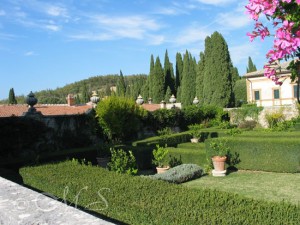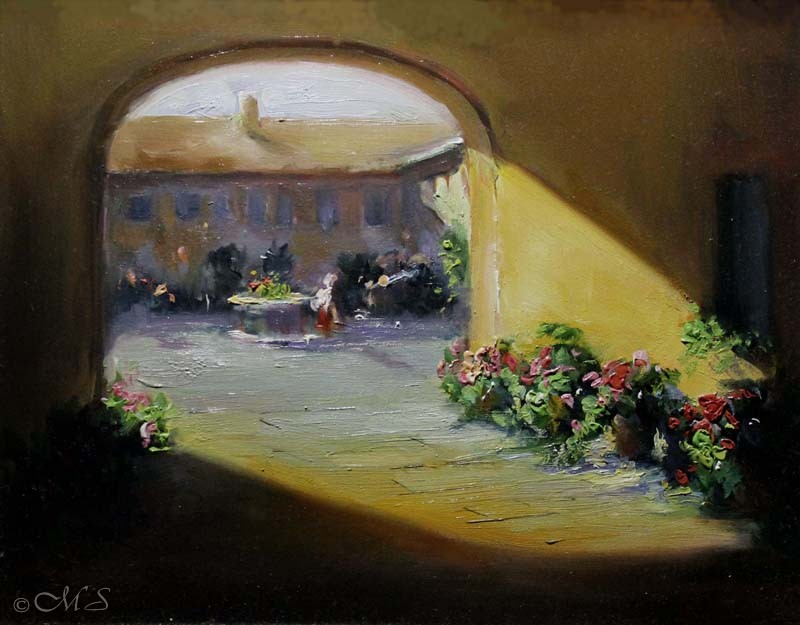The Villa La Foce and its farm are located in southern Tuscany near Pienza and Montepulciano in the clay hills of Sienna/Crete Senesi. It overlooks Val d’Orcia and is a spectacularly beautiful area with a complex history dating back to the Etruscan period (7th century BCE to the 2nd century AD). The Villa was built in the late 1500s as a hospice for pilgrims and merchants traveling on the Via Francigena. We visited La Foce’ one sunny afternoon in the fall of 2003 where I was not able to paint on site but took many, many photographs for future reference.

Why I Choose Local Natural Pigments for my Oil Paintings
The small piece below was painted from a reference photo of the rear entrance to the Villa. Brilliant sunlight was pouring through the arched entrance creating a splendid shadow shape on the wall and floor.
As I began to plan the oil painting, I decided to choose natural pigments that come specifically from Italy – of which there are many. I chose Monte Amiata Sienna Natural and Monte Amiata Natural Earth pigments for my main palette because some of the buildings were actually painted in these faded ochre tones. I added height with brighter yellows (such as lead-tin yellow) and depth with umbers thereby accessing most of the shades necessary. When I needed a cool gray, violet was added to the yellow tones. The town of Monte Amiata, the source of the pigments, is only 30 miles away and I was delighted to see it from the villa.

Copyright Margret E. Short
Kremer vs. Sinopia Natural Pigments
You’ll notice in the color swatches below that the Kremer and Sinopia pigments are very similar. The Kremer pigment has a slightly redder hue but I needed both in this oil painting. Kremer and Sinopia pigments have a slight grittiness which adds to the sparkle on the surface of the canvas. What a pleasure to use so many locally-found pigments.

From left: dry pigment, mixed with linseed oil, brightened with lead-tin yellow, lead-tin yellow.

From left: dry pigment, mixed with linseed, brightened with lead-tin yellow, lead-tin yellow.
The Rich History of La Foce’: Iris and Antonio Origo
Susan Cahill states in Desiring Italy that Iris and Antonio Origo purchased the dilapidated house, farm buildings, and land in 1923. Over the course of their 52 year marriage, they renovated the villa into its former magnificence in addition to opening a school and health clinic for the local children and a home for children left orphaned after World War II. La Foce’ played an important role as a center of the network of resistance that operated in the mountains and valleys of southern Tuscany against the native Italian and occupying German fascists.
Visiting La Foce’ was one of the highlights of our journey to Italy. While we strolled through the gardens enjoying the light and views of the countryside, it was easy to imagine the rich history of the Origos who so generously enhanced the lives of many people of this area. The history is as rich as the amazing pigments that can be found all over Italy. Especially those natural pigments in Monte Amiata…
